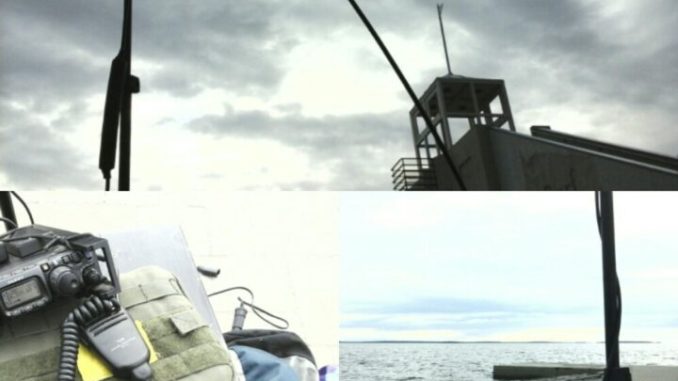
Today was “torturous” 20 kilometer hike to Nallikari in Oulu Finland. Torturous because I haven’t been as active I as should be, since the last RaDAR Challenge. Nevertheless, I changed a few things since the previous days 16km hike. Let’s take a look.
Ditched the framed Pack
The Halti Base 80 is an excellent old school expedition pack. In its hayday, it was at the apex of baseline expedition gear. Fast forward 8 years, and the 3.1kg is kicking my less high-speed, less low-drag butt. The long term solution is dropping 3kg of bodyweight to compensate. The short-term solution is finding a lightweight pack to replace it. Enter the Camelbak!

This Camelbak is so lightweight, I would need chemists scale to measure it. The cost of that lightweight pack comes at the expense of comfort. There’s no frame, there are no wide shoulder straps, and it won’t ride on your hips. What it will do is hug your body. If packed correctly, it will also provide comfort for moderate hikes.
Hiking with the Camelbak
The first 10km to my operating location were easy with the Camelbak. Shoulder straps we’re not cutting into my shoulders, and the lack of weight-bearing hip belt, wasn’t a problem either. On the return trip, around the 15km mark, all that changed. The straps began digging into my shoulders, which was terribly painful. The reality was, I didn’t pack the rucksack correctly before the return trip. I stopped on the side of the path, repacked with heaviest gear closest to my body, then continued on my way.

This Camelbak has also been with me a long time. It’s actually the pack I used back in my Iron Butt motorcycle rally days. The loadout was definitely a stretch for this rucksack. I believe if I would replace the 817 with an Elecraft KX2, the size of this pack would have been perfect for the days goals. The downside is the pack was only large enough for comms gear, 1 liter of water, and an apple. Let’s break down my load-out.
Gear breakdown
- Total payload 7.7kg
- Empty Camelbak 0.700kg
- Comms gear, leatherman, waterbottle, … 7.0kg
– Yaesu FT-817ND
– – Rails
– – WolphiLink
– – Mobilinkd BT TNC
– Chameleon P-LOOP 2.0
– – Booster kit
– – small tripod
– 10Ah battery pack
– PowerFilm F15-1200 solar panel
– Samsung Galaxy Tab Active
– Leatherman wave
– Powerpole distribution unit

Weight saving
- Surprisingly the nickel metal hydride batteries that I use inside the ft-817 are incredibly heavy for what they are. I made a calculated risk by removing them, knowing that doing so would mean a rear connector fail on the 817, would result in a total deployment fail. Good thing these are training ops.
- Dumping the framed Halti Base 80 certainly saved 2.33kg. Unfortunately it did so at the expense of carrying capacity. Here’s where we start to see the differences in casual (comms only) ham radio ops, or ham radio as a utility in the field, where we also need to carry other gear. At 0.700kg, the Camelback is certainly high speed low drag, but limited to comms only deployment. The Base 80 gives me the option of carrying gear needed sustain myselfself in the field for longer deployments. Perhaps an intermediate pack is in the cards.
On the radio
Today I had the pleasure of working IS0DCR in Sardinia on 20m with the P-LOOP 2.0. that was the only voice contact for the day (I wasn’t really trying) . There were other data QSOs on 40 & 30m before heading home.
Field notes
What’s amazing, since starting this gear reduction process, it hasn’t always been done without worry. Batteries, antennas, lightweight backpacks, all help to reduce those ounces and grams. Yes, I can stay in the field longer, I can travel further, but somehow not carrying all that extra gear, is rather worrying, although clearly, it’s not required.

I wondered if the PowerFilm F15-1200 would be adequate for man portable Communications. I mean I know it’s going to have a tough time in winter up here and that’s to be expected. But would it do its job in summer, spring, and Autumn? I chose the F15-1200 as it could provide enough current to power my tablet and radio on a cloudy day (in theory). Well during the qrp portable portion of my 20km hike, it was grey & overcast Skies blocking out the Sun. The F15-1200 continued to provide more power for the 817, than the 817 was using in RX itself. Combine this with the 10Ah lithiuM iron phosphate battery pack, and that still leaves a sickening amount of operating time for the radio. On a bright and sunny day I’ve measured 1.3 amps coming out of the F15-1200, which is more than enough to keep my qrp rig powered and happy.
There are no excuses operators! Get outside.
Minimize your gear and maximize your capabilities
de oh8stn














